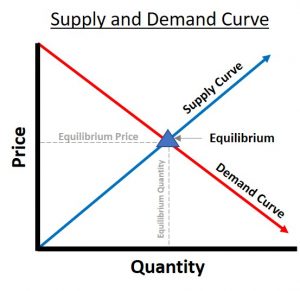What Happens To Equilibrium If Demand Increases
Advertisements
Supply and Demand is an economic model of price determination in a market place. It concludes that in a competitive market, the unit price for a particular good will vary until it settles at a betoken where the quantity demanded past consumers will equal the quantity supplied past producers resulting in an economic equilibrium of price and quantity. This relationship of supply and demand can be seen in a plot of the classic supply-demand curve on the correct. [1]
Advertisements
Definition: The law of supply and need is a theory that explains the interaction betwixt the sellers of a resource and the buyers for that resource.

What are the Supply and Demand Laws?
The Supply and Demand model has ii "laws,": the (1) Police of Need and the (2) Constabulary of Supply. These laws collaborate with each other to determine the marketplace price and volume of appurtenances. The central components to the theory are:
Advertisements
Supply and Demand Outcomes
The four (4) basic outcomes of supply and need are: [iii]
- If demand increases and supply remains unchanged, a shortage occurs, leading to a higher equilibrium price.
- If demand decreases and supply remains unchanged, a surplus occurs, leading to a lower equilibrium price.
- If need remains unchanged and supply increases, a surplus occurs, leading to a lower equilibrium price.
- If demand remains unchanged and supply decreases, a shortage occurs, leading to a higher equilibrium price.
(1) What is the Law of Demand?
The Police of Demand refers to the number of products that people are willing to buy at different prices at a specific time. The constabulary states that the college the price of a product the fewer people volition need the product. As a consumer, the higher a product costs the less the amount of the product the consumer will purchase. This means the opportunity cost of buying that production goes down. [two]
Advertisements
Factors that have influence over the supply are:
- Consumer Preference
- Influence
- Number of Sellers
- Taxes and Regulations
(2) What is the Police force of Supply?
Supply refers to the quantities of production manufactures or owners are willing to sell at different prices at a specific time. The college the toll will consequence in college the quantity supplied. As a seller, the opportunity cost of each product they sell is higher so they want to sell more and producers want to produce more. [1]
Advertisements
Factors that take influence over the supply are:
- Labor and Materials costs
- Technology availability
- Number of sellers
- Capacity
- Taxes and Regulations
What is Supply and Demand Equilibrium?
The market cost is the intersection of the demand price and quantities of products manufactured and the intersection are called the equilibrium price or Market Clearing Price. The equilibrium price is the price at which the producer tin sell all the units he wants to produce and the buyer can purchase all the units he wants.

It is visualized on a chart at the intersection of the supply and demand curve. This intersection is the market price at which suppliers bring to market that aforementioned quantity of product that consumers will be willing to buy. They then say the Supply and Need are in equilibrium. [1]
Purpose of the Supply and Need Theory
The purpose of the Supply and Need theory is to aid people, businesses, bankers, investors, entrepreneurs, economists, government, and others understand and predict conditions in the market for best optimization.
AcqLinks and References:
- [i] Nickels and McHugh, "Understanding Business" McGraw-Colina Irwin 2010
- Price Theory – Supply and Demand Lecture
Updated: half dozen/27/2021
Rank: G16.9
What Happens To Equilibrium If Demand Increases,
Source: https://acqnotes.com/acqnote/careerfields/supply-and-demand
Posted by: wisdomaboaccon.blogspot.com


0 Response to "What Happens To Equilibrium If Demand Increases"
Post a Comment